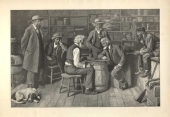The Checker Maven
The World's Most Widely Read Checkers and Draughts Publication
Bob Newell, Editor-in-Chief
Published every Saturday morning in Honolulu, Hawai`i
Noticing missing images? An explanation is here.
Make Haste Slowly

"Make haste slowly" is a saying that comes from the original Greek σπεῦδε βραδέως (we hope your browser displays Greek characters properly) but is better known in the Latin translation, festina lente.
We've always found the concept of "making haste slowly" to be rather interesting. What does it mean, exactly? Does it admonish us to hedge our bets? To proceed directly but with caution? To hurry up and wait?
Adages are often like that; they can mean any number of things.
This month's speed problem may perhaps clarify "making haste slowly," at least from the point of view of the game of checkers. While you need to solve the problem within the time limit of 20 seconds, you will have to carefully visualize and work out the sequence of moves, and that will take the typical checkerist a little time (though certainly not all that much time).
Click below to display the problem and start the clock, then come back and click on Read More to verify your solution.
November Speed Problem (Not so hard; 20 seconds)
![]()
The Fastest Ever

Yes, the photo is blurry. That's because the train is going at about 357 miles per hour, setting a record for the fastest ever. It's the French Train Grande Vitesse and it's a marvel of rail technology.
This month's speed problem is also the fastest ever; though very easy and far from a checker marvel, it's a test of checker intuition. The trick will be to spot the solution within the allowed time limit. This is a "solve at a glance" problem for a player with even moderate experience.
But if you're a newcomer to our game of checkers, you may take a little longer to see how it's done. That's fine, too; it's the process of looking for a solution that's important.
Here we go: click below and think fast! Then come back and click on Read More to see the easy answer to our "fastest" ever speed problem.
October Speed Problem (Very easy; 5 seconds)
![]()
A Familiar Position

The yoga position shown above, we must opine, looks like rather a difficult one, yet the person in the photo seems to have taken it on quite willingly.
In checkers, difficult positions are generally avoided rather than sought. In the diagram below, Black is definitely in such a situation, and may have to go through contortions to find the way to a draw. But, like the yoga position, there is a way to do it.
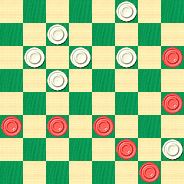
BLACK
Black to Play and Draw
B:W30,27,24,23,22,19,5:B21,13,12,11,10,6,1.
Can you make the necessary twists and turns? If you're a knowledgeable "book" player, the position may indeed look familiar, and you'll likely know how to do it. If it's not familiar to you (yet), it is a good one to learn, so either way, give it a try. If you find yourself in knots, you can always click on Read More to see the run-up, solution, and notes. While you're at it, just for a little additional fun, you might also try to name the yoga position in the photo.![]()
Checker Poetry

The Checker Maven has, we believe, has written and published more original checker fiction than anyone else has ever done. But we've produced very little checker poetry.
Checker poetry used to grace checker books and checker columns, and some of it was very good indeed. The poems often cleverly incorporated problem situations in their verses.
The poem below, kindly provided by Liam Stephens and John Reade, and originally penned by one William Brogan, has been edited slightly to remove an inappropriate ethnic reference and to correct an obvious printer's error.
by Wm. Brogan
There used to live a player
In the town where I was born
Who studied checkers late at night
And early every morn.
This chap was never known
To do a tap of work,
And the neighbours all described him
As a useless lazy jerk.
But opportunity they say
Knocks once at every door.
And Jake was soon to have a chance
To put some gold in store.
A stranger with great riches
Came to this little town,
And he claimed to be a player
Of considerable renown.
He had a roll of greenbacks
That looked like a load of hay,
Said he “This roll I’ll gamble
‘Gainst Jake if he will play.”
Then the town folks they got busy
And they mortgaged home and land,
And they covered every dollar
That the stranger had in hand.
Then the old town hall was hired,
And they called on Lazy Jake.
Saying “ Come and beat the stranger
And we’ll give you half the stake.”
The mayor of the little town
Declared a holiday,
So all the interested ones
Could come and see the play.
The game was quickly started,
Deep silence ruled the place,
And a look of stern defiance
Hovered o’er each player’s face.
The stranger moved quite rapidly
As though he knew his stuff,
While Jake was playing slowly
For he found the going tough.
The following position
Came up and all was done.
So if you are a checkerist
Then show how Jake has won.
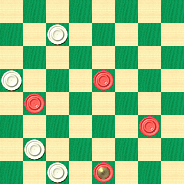
WHITE (Jake)
White to Play and Win
W:W30,25,13,6:BK31,24,17,15.
(Originally published in Wood’s Checker Player, Vol 6, No 3, October 1942.)
And two points White will score
So when you are all finished
Below click on Read More.
![]()
Labor Day 2014

Labor Day 2014 will be on Monday, September 1, and each year The Checker Maven takes the opportunity to join in honoring American workers, the men and women who work hard day in and day out to make America the great nation that it is. Whether you're a business executive, police officer, gardener, nurse, construction worker, or belong to any of the thousands of other occupations that make up the American workforce, you're worthy of our salute. In America, all honest work is respected, and rightly so.
Checkers was once the mind sport of the working class and many of the great masters were American workers. One of them was steelworker Asa Long, and today we present a position taken from one of his games.
| 1. | 11-15 | 23-19 |
| 2. | 9-14 | 22-17 |
| 3. | 7-11 |
Forms the Whiltier opening.
| 3. | ... | 25-22 |
| 4. | 11-16 | 26-23 |
| 5. | 5-9 | 17-13 |
| 6. | 3-7 | 29-25 |
| 7. | 7-11 | 24-20 |
| 8. | 15-24 | 28-19 |
| 9. | 11-15 | 20-11 |
| 10. | 15-24 | 27-20 |
| 11. | 8-15 | 30-26 |
| 12. | 4-8 | 20-16 |
Book play up to here, where the KingsRow engine now gives 31-27 instead.
| 13. | 12-19 | 23-16 |
| 14. | 8-11 | 16-7 |
| 15. | 2-11 | 26-23 |
| 16. | 11-16 | 31-26 |
| 17. | 15-18 | 22-15 |
| 18. | 10-19 | 25-22 |
| 19. | 1-5 | 22-17 |
| 20. | 14-18 | 23-14 |
| 21. | 9-18 | 17-14 |
| 22. | 16-20 |
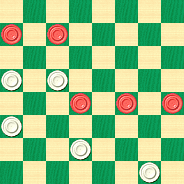
WHITE
White to Play and Draw
W:W32,26,21,14,13:B20,19,18,6,5.
You definitely have your work cut out for you in this one. Can you labor hard enough to find the White draw? When you've completed the job, clock out by clicking on Read More to see the solution.![]()
![]()
Showdown in West Texas

The small group crowded around the table in the rear of the saloon backed away a few steps, still watching, but now wary.
It had all started around an hour ago. Old Billy Matson came into the saloon around one in the afternoon, as he did nearly every day, and took his usual seat at his usual table, back to the wall, a clear view through the length of the saloon all the way to the swinging doors in the front. Not that there was generally much danger, but you never could tell, and Billy didn't get to be "Old Billy" by being careless.
He set up his checkerboard, again just like always. The folding board was getting a little tattered and the checker pieces were pretty grimy, but he didn't care and the few who said anything received the merest of shrugs by way of reply. Appearances and aesthetics weren't what it was all about.
It would surprise no one that the main concern was money: stakes won and, much less often, lost by Billy; wagers among the spectators as to who would win, although if you were going to bet against Billy you'd better get long odds, because Billy didn't lose that much. He dropped just enough games to keep the marks coming. It wouldn't have done to win every single game and make taking him on seem hopeless.
But today, things weren't going the way they usually did. A stranger had come into town, riding a Palomino and wearing a six-shooter low on his hip. The first thing he did after he hitched his horse was to ask one of the townsfolk where he could find Old Billy.
"Whatcha looking for Billy for? He don't never do nothin' but play checkers in the saloon," the townsman replied. It was Chet Johnson, the farrier.
The stranger gave Chet a look that made Chet step back involuntarily. "I ain't gotta give you no reason," the stranger said. "Answer my question. Where's Old Billy?"
"The ... the saloon, like I said," Chet replied, and then lit off as fast as he could.
The saloon was easy to spot; it was the biggest building along Main Street. The stranger went on over and pushed through the swinging doors, letting them flap behind him. The barkeep raised his head as if to say something, but one look at the stranger made him change his mind. "Old Billy. He here?" the stranger demanded.
"In the back," the barkeep said, and then tried to look really busy polishing glasses.
The stranger walked to the back, his spurs clicking against the wood floor. When he reached Billy's table, he leaned his arms on it and bent forward, his face mere inches from Billy's.
"You Billy Matson?" he asked.
"Yep, that's me." Billy had met swaggering challengers before and he knew enough to keep his cool and not get stared down or intimidated. "Who's askin'?"
The stranger leaned back, then pulled out a chair and sat down on the other side of the checkerboard. "I'm Danny Douglas, and I hear you're good at checkers."
"Some say that I am," Billy said.
"Well, you ain't as good as me and I'm gonna prove it. I'm the best. The best with a gun and the best with checkers."
"I figure you're here to show me your checker skill, not your gunfighting skill?"
Danny laughed. "You're a funny one, ain't cha. Either way, old man, I can take you either way."
"Then I suggest we stay with checkers."
"Sure," Danny said, "that suits me fine. A hundred a game?"
That was a really big stake, enough to make even Billy think twice, and besides, he wasn't sure if he could come up with the cash if he lost. But he'd been in this kind of situation before, and he hadn't ever backed down. Doggoned if he'd do it now, especially with a cocky gunslinger who thought he could play checkers.
"You're on," Billy said. "First one to win two games collects a hundred bucks."
Danny just nodded and, since the Black pieces were facing him, made the first move.
A few people had overheard the conversation and started to take an interest. A couple of side bets were made.
Half an hour passed, and Danny won the first game.
The buzz among the spectators increased. Someone ran outside and must have told some others, for a few minutes later he came back followed by at least a half a dozen townsfolk, all of whom went straight to the back of the saloon to watch the action.
Billy wasn't sure what had happened in that first game. Danny was good, real good; there was no denying it. Billy knew he'd have to buckle down. This was no easy mark.
Billy won the second game. The gunslinger swore a few times but then stopped himself. "All right, old man," he said. "You're as good as I heard you were. But you ain't gonna win the next game, and then I'll be livin' high on that hundred you'll owe me."
Billy didn't reply.
The crowd of onlookers was in a real state. They had never seen anything like this. No one had ever put up a real contest with Billy, not like this one. Money was changing hands and some large wagers were made on the third and final game.
Both players were very cautious, taking their time with their moves. Slowly but surely, it looked like Danny was getting a little bit of an advantage. He pressed hard, and though Billy fought back, Danny's advantage increased. Finally, the position was like this. Billy had White and it was his turn to move.
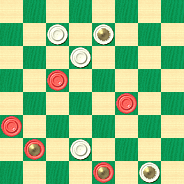
WHITE
White to Play and Draw
W:WK32,26,10,K7,6:BK31,K25,21,19,14.
It looked pretty bad. Billy was going to go a man down and there wasn't anything he could do about it. Danny knew it and was sitting back in his chair, his thumbs hooked in his gun belt, a smirk on his face.
Billy was looking for a way out, but in the back of his mind was the frightening thought that he'd end up owing a hundred bucks to this gunslinger, with no way to pay it. That wouldn't be good. Maybe the Sheriff could intervene; he'd get likely get word of the goings-on at the saloon and come to check up on things. Billy could only hope for something like that.
Unless ... suddenly, Billy saw a line of play that he hadn't considered before. Yes ... there was only one move that could save things ... if he moved there, Danny would have to choose between ... yes. That was it!
He raised his head from the board and looked over at the still-smirking Danny. Billy smiled at him, then let the smile vanish from his face, replaced by a serious, deadly look.
"Draw!" he said suddenly and loudly.
There was an explosion and Billy fell back in his chair, a bullet hole in the middle of his forehead, Danny's smoking gun pointed right at him, no more than a foot away.
"Drop it!" That was the Sheriff. He had come in just as the shot was fired. He was holding his gun in both hands, keeping it steady on Danny.
Danny knew better than to try anything. He slowly lowered his six-shooter and placed it gently on the table. He was careful not to disturb the checkerboard.
"You're under arrest for the murder of Billy Matson!" the Sheriff declared.
Still careful not to make a sudden move, Danny said, "Murder! What do you mean! He challenged me!"
"Ain't the way I saw it," said one of the braver bystanders. "You drew down on him an' plugged him, and he didn't do nothin' afore you killed 'im."
"Draw!" Danny said. "He said draw, so I did! He woulda killed me if I hadn't."
The bystander started to laugh. He probably felt safe with the Sheriff keeping his gun on Danny. "Ha ha! That's a good one! Billy don't even carry no gun! When he said 'draw' he meant the game was a draw. Cain't cha see that? I thought you was some kind a good player but I guess you ain't, and now you're gonna swing for it!"
Danny Douglas did hang for the murder of Old Billy Matson, but the town was never the same, and no one would play checkers again in the back of the saloon.
In the diagram above, White does have a draw but it will take a "star" move to make it happen. Can you do it? Solve the problem and then draw your mouse over to Read More to check your solution. Just be careful what you say and how you say it in a West Texas saloon!![]()
Lightning Stroke

Lightning storms are common during summer in much of North America. Some lightning-prone areas have a keraunic level of over 100, which means there is lightning activity an average of 100 days per year. But science marches on, and the traditional keraunic level statistic is being replaced with the more informative flash density measurement. That's another topic, though, and a rather electrifying one.
This month we present a stroke problem that is neither modern nor difficult, but definitely informative. We think you'll agree that the solution is like a stroke of lightning: quick and powerful, no matter what your means of measurement.
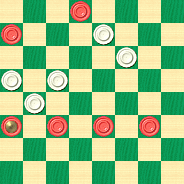
WHITE
White to Play and Win
W:W17,14,13,11,7:B24,23,22,K21,5,2.
Blitz this problem and then flash your mouse on Read More to see the solution.![]()
Famous Shots IX

Our Checker School series of Famous Shots concludes this month, and as in previous entries, we ask you to solve the shot, name the shot, and, if you wish, name the "shot" in the photo above. During the past eight months we've taken a tour of the checker "big shots"; these are positions that every learner must master and every master must know.
Here's the finale, with the full run-up. Once again the game is not especially well played, but the ending is great.
11-15 23-18 8-11 27-23 4-8 23-19 10-14 19x10 14x23 26x19 7x14 19-15 11x18 22x15 14-18 21-17---A 12-16 24-20 16-19 20-16 2-7 17-13---B 9-14---C 31-26 5-9 25-21---D 18-23---E 29-25---F 14-18---G 21-17---H 7-11---I 16x7 3x10 (see diagram)
A---24-19 is probably better, although deep computer analysis doesn't shown a Black advantage.
B---Ouch. 25-22 was best. This move might actually lose for White.
C---19-23 was better.
D---Loses; 16-12 was better.
E---7-11 would have won. This return blunder is only good for a draw.
F---Loses again! 16-12 was fine.
G---Gives the draw back again! 7-11 wins.
H---Doesn't lose but gives Black a real edge. White just doesn't seem to want to play 16-12.
I---8-12 was best. The game now unravels for Black.
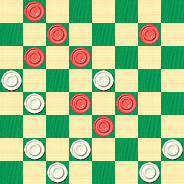
WHITE
White to Play and Win
W:W32,30,28,26,25,17,15,13:B23,19,18,10,9,8,6,1.
This one isn't too difficult, at least as far as these things go, so shoot it down and then click on Read More to check your answer.![]()
July Speed Problem

It's summer, and we hope you are able to get out and enjoy summer sports, such as a speedy ride on a bicycle. The winter of 2013-14 was pretty harsh in most of North America, and we're certain you're happy to be outdoors. Do it while you can, summer doesn't last forever. Unless you're in Hawai`i, of course!
Our speed problem for July isn't especially hard, but we're still allowing you 30 seconds to solve it. Such generosity! It's a very practical setting and we hope you like it. When you're ready, click on the link below; then come back and click on Read More to verify your solution.
July Speed Problem (30 seconds, relatively easy)
![]()
4th of July Special

Every year we say the same thing: we love celebrating the Fourth of July, America's birthday. We are proud to be American patriots, and invite our American readers to celebrate along with us.
Similarly, every Fourth of July we turn to a man who served America with honor and distinction, Mr. Tom Wiswell. This year, we present a situation from one of his matches with Millard Hopper, yet another patriot and, like Mr. Wiswell, a champion go-as-you-please player.
Here's the situation.
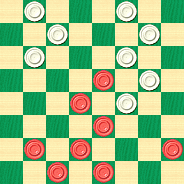
BLACK
Black to Play and Draw
B:W32,30,27,25,24,22,17,14:B18,15,10,8,7,5,3,2.
It's quite a complex situation but the draw is there and you can work it out with some effort. Find the solution and then celebrate by clicking on Read More to check your answer and to see the transcription of the full game.![]()
The Checker Maven is produced at editorial offices in Honolulu, Hawai`i, as a completely non-commercial public service from which no income is obtained or sought. Original material is Copyright © 2004-2026 Avi Gobbler Publishing. Other material is public domain, AI generated, as attributed, or licensed under CC1, CC2, CC3 or CC4. Information presented on this site is offered as-is, at no cost, and bears no express or implied warranty as to accuracy or usability. You agree that you use such information entirely at your own risk. No liabilities of any kind under any legal theory whatsoever are accepted. The Checker Maven is dedicated to the memory of Mr. Bob Newell, Sr.

